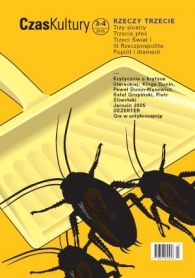Co to jest Trzeci Świat?
What Is the Third World?
Author(s): Joanna Mieszko-WiórkiewiczSubject(s): Politics / Political Sciences
Published by: Stowarzyszenie Czasu Kultury
Summary/Abstract: The Third World, countries fighting against poverty … countries robbed by greedy superpowers … countries deprived of political and economic independence … countries where children work for global corporations … “What (and not ‘who’) is the inhabitant of the Third World?”, asks Joanna Mieszko-Wiórkiewicz. European colonialism, a 500-year history of ruthless exploitation and fortunes made at the expense of other nations and their resources, is not a thing of the past. Despite the fact that Third World countries have achieved the independence they had so much longed for, the greed of the First World leaves no room for their autonomous development. Modern capitalism is a continuation of colonial history. Countries like the United Kingdom, Spain, Portugal, Belgium and France still make profits from underprivileged states. The USA, Russia (which is now officially included in the First World, despite its terrifying levels of corruption) and Germany know very well how to “keep a firm hand on the resources” of Columbia where the poverty in society constitutes and incredible contrast to the local export of emeralds, gold, oil and coffee. Any opposition groups and trade unions are instantly suppressed by the Columbian government surrounded by a White House-financed paramilitary network. Bolivia, “today, is the poorest country in South America. Its resources of gold, silver and zinc have been nearly completely robbed.” And this has been ‘achieved’ by the American superpower. The TRIPs Treaty prevents Third World countries from dealing with growing waves of AIDS and malaria, because they cannot produce their own medications and for the imported ones they have to pay as much as First World countries. The ongoing conflict between the Sinhalese and the Tamils in Sri Lanka is the result of British colonialism which in its greed for increased coffee production ‘imported’ the Tamils from Southern India, as a cheap labour force, despite knowing that the two ethnic groups had always been enemies. Since then the island has been the stage for continuous struggles between them. The Third World is also the place where children have been forced into the (neo)colonial machine. “Are not children the ones who make shoes and balls for Adidas and Ecco, who polish cheap marble for our tombstones and who excavate wolfram in the mines of Latin America for our light bulbs? Is there anything that children cannot do? The scope of work provided by children is so extensive that if all the working children of the world would go on strike one day, the rest of the us would feel the effects of this only one week later.” This is the contribution of children to the ruthlessly efficient wheel of heartless capitalism, a contribution that the international community does not even think to protest against.
Journal: Czas Kultury
- Issue Year: 2005
- Issue No: 03-04
- Page Range: 62-77
- Page Count: 16
- Language: Polish
- Content File-PDF

